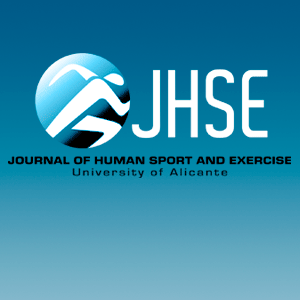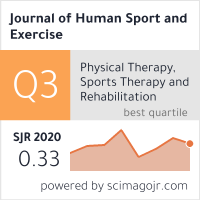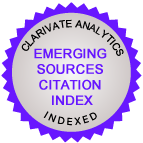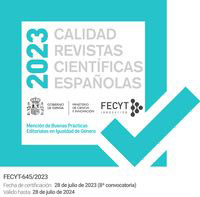Effect of efitbuddy on promoting physical activity and motivation in college students
DOI:
https://doi.org/10.14198/jhse.2018.134.08Keywords:
Smartphone application, Physical activity, Enjoyment, Self-efficacy, College studentAbstract
The purpose of this study was to examine the effect of a theory-based smartphone application, efitbuddy, on college students’ physical activity and motivation. A convenience sample of 106 college students (mean age = 20.4 ± 2.8 years; 77 females) were recruited from a university located in the Northeastern U.S. Participants installed the efitbuddy application on their smartphone, and used it every day over a 2-week time period. Physical activity was measured using a self-recall questionnaire and motivational variables were collected using established surveys. All measures were collected at baseline and at a 2-week post-test time-point. A 2 × 2 Doubly Multivariate Analysis of Covariance (MANCOVA) test was employed to test time main effect and the sex × time interaction effect on each outcome measure, using age as covariate.Results of the study indicated that there was a statistically significant multivariate model (Wilks’ = 0.87, F (12, 542.7)= 2.49, p = 0.003). Statistically significant effects included a sex main effect (F (1, 205) = 4.98, p = 0.002) and the statistical significance of the age covariate (F (3, 205) = 3.73, p = 0.012). There were no significant time main effects (p = 0.594). To conclude, efitbuddy has limited effect on young adults’ physical activity and motivation over a 2-week intervention. Additional research with longer intervention periods should be conducted to explore potential effectiveness.
Downloads
References
Banas, T. (2017). How to Convert Pedometer Steps to Calories. Retrieved from https://www.livestrong.com/article/238020-how-to-convert-pedometer-steps-to-calories/
Bandura, A. (1991). Social cognitive theory of self-regulation. Organizational Behavior and Human Decision Processes, 50, 248-287. https://doi.org/10.1016/0749-5978(91)90022-L
Bort-Roig, J., Gilson, N., Puig-Ribera, A., Contreras, R., & Trost, S. (2014). Measuring and Influencing Physical Activity with Smartphone Technology: A Systematic Review. Sports Medicine, 44(5), 671-686. https://doi.org/10.1007/s40279-014-0142-5
Conroy, D. E., Yang, C., & Maher, J. P. (2014). Behavior Change Techniques in Top-Ranked Mobile Apps for Physical Activity. American Journal Of Preventive Medicine, 46(6), 649-652. https://doi.org/10.1016/j.amepre.2014.01.010
Conroy, M. B., Yang, K., Elci, O. U., Gabriel, K. P., Styn, M. A., Wang, J., & Burke, L. E. (2010). Physical activity self-monitoring and weight loss: 6-month results of the SMART trial. Medicine & Science in Sports & Exercise, 43, 1568-1574. https://doi.org/10.1249/MSS.0b013e31820b9395
Coughlin, S. S., Whitehead, M., Sheats, J. Q., Mastromonico, J., & Smith, S. (2016). A Review of Smartphone Applications for Promoting Physical Activity. Jacobs Journal Of Community Medicine, 2(1).
Crocker, P. E., Bouffard, M., & Gessaroli, M. E. (1995). Measuring enjoyment in youth sport settings: a confirmatory factor analysis of the Physical activity enjoyment scale. Journal Of Sport & Exercise Psychology, 17200-205. https://doi.org/10.1123/jsep.17.2.200
Department of Health and Ageing. (1999). National physical activity guidelines for Australians. Canberra, ACT, Australia: Author.
Fan, X., Miller, B. C., Park, K., Winward, B. W., Christensen, M., Grotevant, H. D., & Tai, R. H. (2006). An Exploratory Study about Inaccuracy and Invalidity in Adolescent Self-Report Surveys. Field Methods, 18(3), 223-244. https://doi.org/10.1177/152822X06289161
Fukuoka, Y., Kamitani, E., Dracup, K., & So Son, J. (2011). New Insights Into Compliance With a Mobile Phone Diary and Pedometer Use in Sedentary Women. Journal Of Physical Activity & Health, 8(3), 398-403. https://doi.org/10.1123/jpah.8.3.398
Fukuoka, Y., Vittinghoff, E., Jong, S. S., & Haskell, W. (2010). Innovation to motivation—pilot study of a mobile phone intervention to increase physical activity among sedentary women. Preventive Medicine: An International Journal Devoted To Practice And Theory, 51(3-4), 287-289. https://doi.org/10.1016/j.ypmed.2010.06.006
Hebden, L., Cook, A., van der Ploeg, H. P., & Allman-Farinelli, M. (2012). Development of smartphone applications for nutrition and physical activity behavior change. JMIR Research Protocols, 1(2), e9. https://doi.org/10.2196/resprot.2205
Huong Q, N., Dawn P, G., Seth, W., & et, a. (2009). Pilot study of a cell phone-based exercise persistence intervention post-rehabilitation for COPD. International Journal Of COPD, Vol 2009, Iss Default, Pp 301-313.
Kendzierski, D., & DeCarlo, K. J. (1991). Physical activity enjoyment scale: two validation studies. Journal Of Sport & Exercise Psychology, 1350-64. https://doi.org/10.1123/jsep.13.1.50
Kuroda Y, Sato Y, Ishizaka Y, Yamakado M, Yamaguchi N. Exercise motivation, self-efficacy, and enjoyment as indicators of adult exercise behavior among the transtheoretical model stages. Glob Health Promot, 2012; 19:14-22. https://doi.org/10.1177/1757975911423073
Lewis, Z. H., Lyons, E. J., Jarvis, J. M., & Baillargeon, J. (2015). Using an electronic activity monitor system as an intervention modality: A systematic review. BMC Public Health, 15585. https://doi.org/10.1186/s12889-015-1947-3
Michie, S., Abraham, C., Whittington, C., McAteer, J., & Gupta, S. (2009). Effective techniques in healthy eating and physical activity interventions: A meta-regression. Health Psychology, 28, 690-701. https://doi.org/10.1037/a0016136
Middelweerd, A., Mollee, J. S., van der Wal, C. N., Brug, J., & te Velde, S. J. (2014). Apps to promote physical activity among adults: A review and content analysis. The International Journal Of Behavioral Nutrition And Physical Activity, 11. https://doi.org/10.1186/s12966-014-0097-9
Middelweerd, A., van der Laan, D. M., van Stralen, M. M., Mollee, J. S., Stuij, M., te Velde, S. J., & Brug, J. (2015). What features do Dutch university students prefer in a smartphone application for promotion of physical activity? A qualitative approach. International Journal Of Behavioral Nutrition & Physical Activity, 121-11. https://doi.org/10.1186/s12966-015-0189-1
Moore, J. B., Yin, Z., Hanes, J., Duda, J., Gutin, B., & Barbeau, P. (2009). Measuring Enjoyment of Physical Activity in Children: Validation of the Physical Activity Enjoyment Scale. Journal Of Applied Sport Psychology, 21116-129. https://doi.org/10.1080/10413200802593612
Motl, R. W., Dishman, R. K., Saunders, R., Dowda, M., Felton, G., & Pate, R. R. (2001). Measuring enjoyment of physical activity in adolescent girls. American Journal Of Preventive Medicine, 21(2), 110-117. https://doi.org/10.1016/S0749-3797(01)00326-9
Neve, M., Morgan, J. P., & Collins, E. C. (2011). Weight change in a commercial web-based weight loss program and its associa¬tion with website use: Cohort study. Journal of Medical Inter¬net Research, 13(4), e83. https://doi.org/10.2196/jmir.1756
Nguyen, E., Bugno, L., Kandah, C., Plevinsky, J., Poulopoulos, N., Wojtowicz, A., & Greenley, R. N. (2016). Is there a good app for that? Evaluating m-health apps for strategies that promote pediatric medication adherence. Telemedicine And E-Health, 22(11), 929-937. https://doi.org/10.1089/tmj.2015.0211
Pagano, M., Gauvreau, K. (2000). Principles of Biostatistics (2nd Ed.). Belmont, CA: Brooks/Cole, Cengage Learning.
Stephens, J., & Allen, J. (2013). Mobile phone interventions to increase physical activity and reduce weight: A systematic review. Journal Of Cardiovascular Nursing, 28(4), 320-329. https://doi.org/10.1097/JCN.0b013e318250a3e7
Stuckey, M., Russell-Minda, E., Read, E., Munoz, C., Shoemaker, K., Kleinstiver, P., & Petrella, R. (2011). Diabetes and Technology for Increased Activity (DaTA) study: results of a remote monitoring intervention for prevention of metabolic syndrome. Journal Of Diabetes Science And Technology, 5(4), 928-935. https://doi.org/10.1177/193229681100500416
Welk, G. (2002). Physical activity assessments for health-related research. Champaign, IL.; Human Kinetics.
Wing, R. R., & Phelan, S. (2005). Long-term weight loss main¬tenance. American Journal of Clinical Nutrition, 82(1), 222S-225S. https://doi.org/10.1093/ajcn/82.1.222S
Downloads
Statistics
Published
How to Cite
Issue
Section
License
Copyright (c) 2018 Journal of Human Sport and Exercise

This work is licensed under a Creative Commons Attribution-NonCommercial-NoDerivatives 4.0 International License.
Each author warrants that his or her submission to the Work is original and that he or she has full power to enter into this agreement. Neither this Work nor a similar work has been published elsewhere in any language nor shall be submitted for publication elsewhere while under consideration by JHSE. Each author also accepts that the JHSE will not be held legally responsible for any claims of compensation.
Authors wishing to include figures or text passages that have already been published elsewhere are required to obtain permission from the copyright holder(s) and to include evidence that such permission has been granted when submitting their papers. Any material received without such evidence will be assumed to originate from the authors.
Please include at the end of the acknowledgements a declaration that the experiments comply with the current laws of the country in which they were performed. The editors reserve the right to reject manuscripts that do not comply with the abovementioned requirements. The author(s) will be held responsible for false statements or failure to fulfill the above-mentioned requirements.
This title is licensed under a Creative Commons Attribution-NonCommercial-NoDerivatives 4.0 International license (CC BY-NC-ND 4.0).
You are free to share, copy and redistribute the material in any medium or format. The licensor cannot revoke these freedoms as long as you follow the license terms under the following terms:
Attribution — You must give appropriate credit, provide a link to the license, and indicate if changes were made. You may do so in any reasonable manner, but not in any way that suggests the licensor endorses you or your use.
NonCommercial — You may not use the material for commercial purposes.
NoDerivatives — If you remix, transform, or build upon the material, you may not distribute the modified material.
No additional restrictions — You may not apply legal terms or technological measures that legally restrict others from doing anything the license permits.
Notices:
You do not have to comply with the license for elements of the material in the public domain or where your use is permitted by an applicable exception or limitation.
No warranties are given. The license may not give you all of the permissions necessary for your intended use. For example, other rights such as publicity, privacy, or moral rights may limit how you use the material.
Transfer of Copyright
In consideration of JHSE’s publication of the Work, the authors hereby transfer, assign, and otherwise convey all copyright ownership worldwide, in all languages, and in all forms of media now or hereafter known, including electronic media such as CD-ROM, Internet, and Intranet, to JHSE. If JHSE should decide for any reason not to publish an author’s submission to the Work, JHSE shall give prompt notice of its decision to the corresponding author, this agreement shall terminate, and neither the author nor JHSE shall be under any further liability or obligation.
Each author certifies that he or she has no commercial associations (e.g., consultancies, stock ownership, equity interest, patent/licensing arrangements, etc.) that might pose a conflict of interest in connection with the submitted article, except as disclosed on a separate attachment. All funding sources supporting the Work and all institutional or corporate affiliations of the authors are acknowledged in a footnote in the Work.
Each author certifies that his or her institution has approved the protocol for any investigation involving humans or animals and that all experimentation was conducted in conformity with ethical and humane principles of research.
Competing Interests
Biomedical journals typically require authors and reviewers to declare if they have any competing interests with regard to their research.
JHSE require authors to agree to Copyright Notice as part of the submission process.






